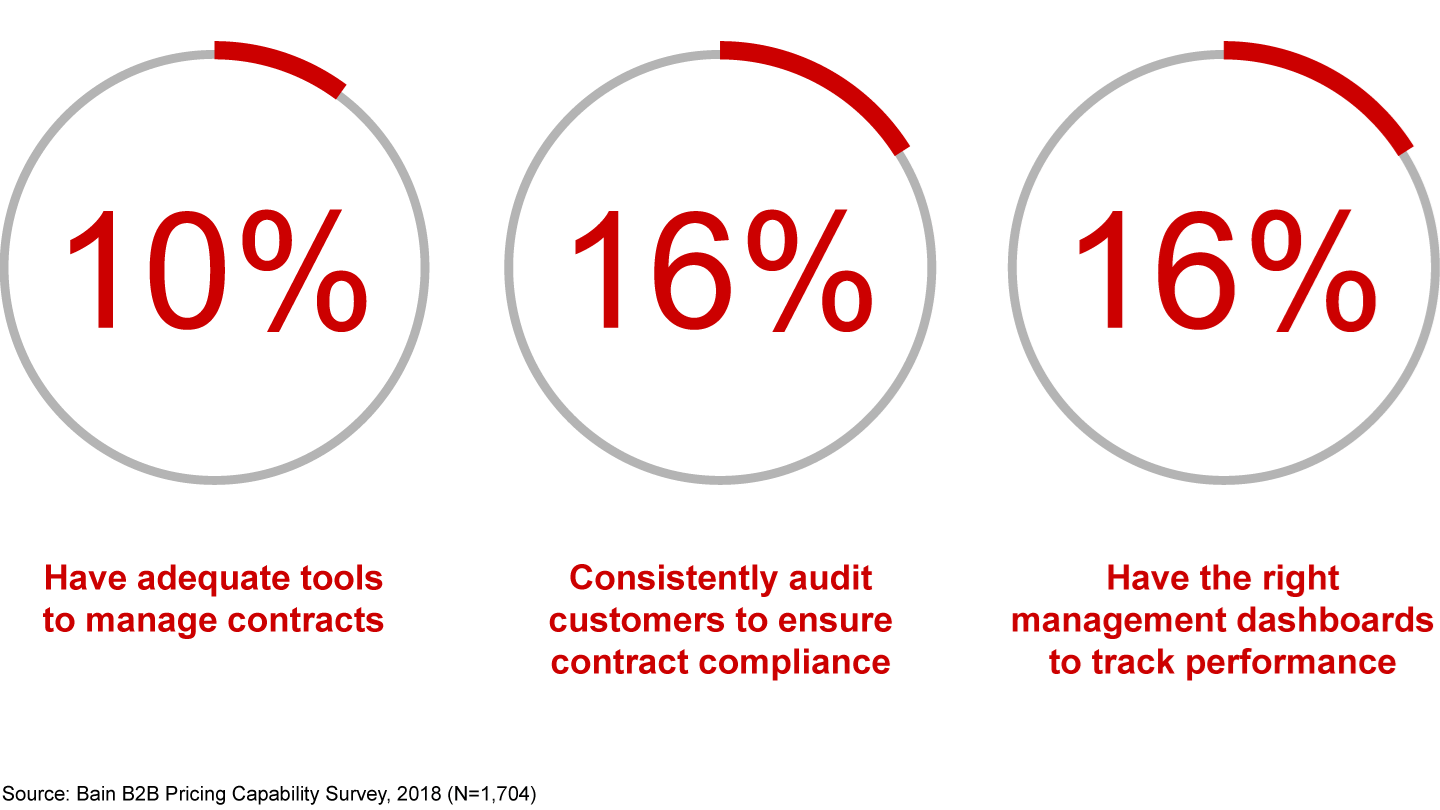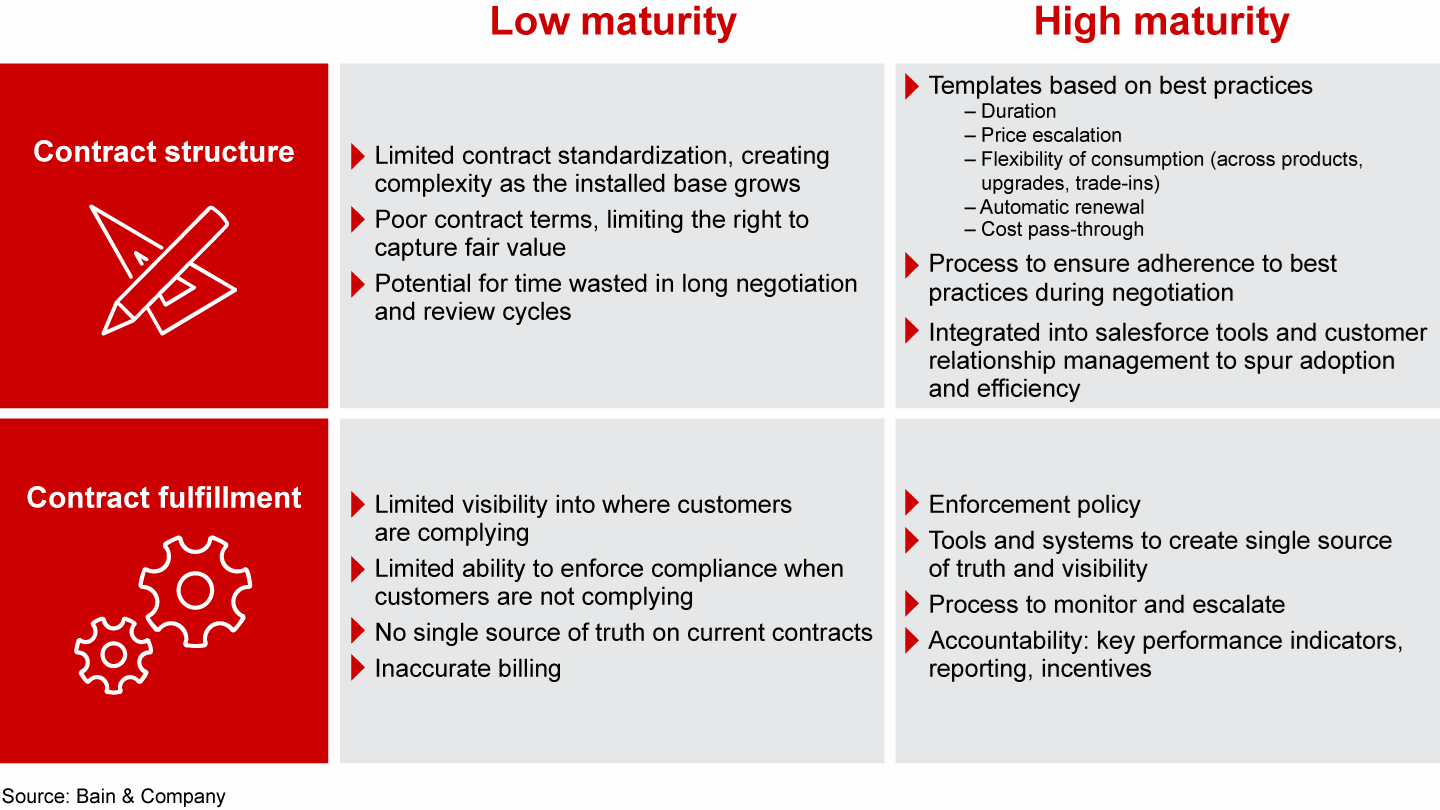Brief

Auf einen Blick
- Many business-to-business companies are leaking large sums of cash due to sloppy contract management. Too often, a contract goes into an electronic drawer where it cannot be easily accessed, analyzed or tracked.
- Wringing full value from contracts requires an airtight contract structure and robust fulfillment.
- Building mature capabilities entails steps that include a single data house with easy access, processes supported by the right digital tools, coaching for the front line and accountability for contract enforcement.
Sloppy contract management is like leaving cash lying on the sidewalk.
Consider the cable provider that negotiated a contract with a computer hardware vendor specifying a 60% discount off list price. The discount was incorrectly entered into the vendor’s enterprise resource planning system as 65%, so for many years, the cable provider received an extra 5-point discount to which it was not entitled. After the vendor discovered this leak, it tightened up its systems, but at a cost of tens of millions of dollars in leaked revenue.
A microchip manufacturer had a different problem. It had supplied a huge volume of chips to a cell phone manufacturer that had a smash hit with one of its models. When the next model of the phone was designed, the contract specified a major discount for buying the same number of chips, with a higher unit price for fewer chips. Two years later, the new phone turned out to be a relative dud, but the microchip manufacturer had no process in place to monitor or enforce the contract.
Contract management has historically been a weakness for business-to-business (B2B) companies. According to a recent Bain & Company survey, only 16% of nearly 1,700 pricing executives expressed confidence that their companies have the appropriate dashboards in place to track the performance of their customer contracts or that they consistently audit customers to ensure compliance (see Figure 1).
Addressing revenue leakage from weak contract management takes on greater urgency during the current coronavirus crisis. (Of course, the pandemic’s toll on human health remains top of mind for companies trying to protect their employees and customers.) Many B2B sectors will likely see little or no new customer growth for some time. Customer noncompliance with the contract could increase, and more customers are already asking for price reductions.
Most business-to-business companies are leaking value through their contracting practices


All too often, after the sales and legal teams agonize over contract details and approvals, the contract goes into an electronic drawer where it cannot be easily accessed, analyzed or tracked. The contract does not get codified for standard variables such as volume-triggered rebates or payment terms. The company misses stipulated price increases, fails to meter seat licenses or neglects to adjust prices for fluctuations in raw material costs.
As a result, many B2B companies are leaking a substantial amount of cash each year.
An opportunity worth 100 basis points of revenue and profit
Smart contract management thus creates significant benefits throughout the crisis. In addition, it keeps paying dividends once the economy recovers. In our experience, optimizing contracts provides 100 basis points or more of additional revenue and profit. The benefits can start immediately, using manual efforts to improve the enforcement of contracts that already exist.
Wringing full value from contracts requires an airtight contract structure and robust fulfillment. Responsibility for these often sits with different parts of the organization—the former with sales, the latter with customer care—and the value realized breaks down at the weakest link. A more mature level of management in each area, by contrast, includes detailed templates for new contracts and active governance of contract adherence, using dashboards to monitor the health of contracts and the effectiveness of renewals over time (see Figure 2).
Mature contract management relies on templates, access to the data for analysis and strong accountability


Companies can improve their contract management capabilities by taking a few key steps.
- Put the data house in order. Create a single source of truth for all customer contracts, with easy access for the relevant teams.
- Assess the opportunity. Analyze revenue leakage relative to contract terms such as volume minimums or tiered pricing, then plan how to fill the gaps once conditions stabilize.
- Establish processes supported by the appropriate digital tools. These are essential for sustainable contract monitoring, without which the benefits can quickly fade.
- Coach the front line on new expectations. Sales representatives need more than encouragement to write compliant contracts; they need the right process and tools.
- Hold people accountable. Establish accountability for monitoring and enforcing contract terms. Clear, personalized dashboards that track performance will support compliance as well as the ability to measure and improve returns on customer investments and contract concessions.
The experience of one major technology company illustrates the size of the opportunity. Its service contracts entitled customers to download updates and upgrades for their software, but a valid contract of any kind unintentionally allowed a customer access to any software that the company offered, without having paid for it. For example, a contract for software product A could be used to upgrade multiple copies of that product but also to obtain a copy of software product B.
The company took a segmented approach to enforcing entitlement based on how easy it would be to implement the new rules and on how each segment would react. As a result, the company was able to capture $300 million in unrealized revenue and identified more than $500 million to which it was already entitled.
As the technology company’s experience illustrates, full-on contract enforcement must be weighed against maintaining good relationships with customers. There are ways for B2B suppliers to get their fair share of value without damaging customer loyalty. Making customers aware is a good start, as they may not know that they are not compliant. Fees or penalties for past noncompliance could be waived if the supplier gives notice regarding how they will be enforced in the future.
For some fortunate customers that have greatly increased their use of the product, it’s worth discussing an upgrade to a higher-usage tier or premium package. For others, it may make sense to lock in a long-term contract renewal.
Sometimes maximizing contract value is as simple as changing processes from “opt in” to “opt out.” For example, one building equipment manufacturer included 3% annual price increases in its contracts but had been following through on the price increases in only one-third of cases. The process to execute the increase depended on individual account reps taking action. Many reps did not bother, as each increase required an uncomfortable client conversation and had little effect on their compensation. To solve the problem, the manufacturer set up a dedicated team to execute price increases. Account reps could still appeal to stop price increases from going through, but few actually did. For a modest investment of time and resources, the manufacturer now executed price increases on more than two-thirds of its contracts and reaped an extra 100 basis points of profit growth.
Customers generally view these actions as fair if communicated openly and in the spirit of goodwill. They may even develop a greater appreciation for the value brought to their organization.
And that’s as good as stumbling across cash on the sidewalk.